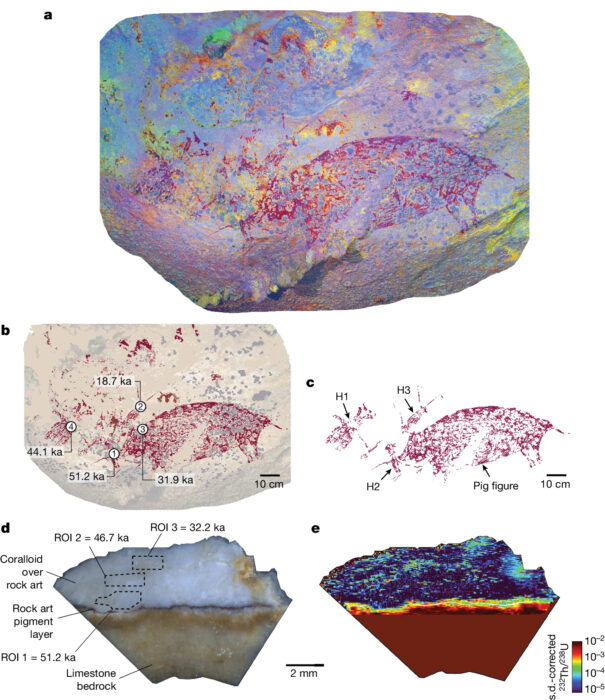Scientists have discovered a painting of three human figures surrounding a large pig in a cave on the island of Sulawesi in Indonesia. Using a new technique where a laser nips off several tiny pieces of the pigment for analysis, they dated the work to 51,200 years ago — 5,000 years older than the oldest previously known cave painting.
They also re-dated other art in the same cave complex to roughly 49,000 years old, 4,000 years older than first thought. The multiple laser samplings do not noticeably damage the art but give a much more accurate reading.

Figures from the paper, published in the journal ‘Nature.’ Images: Adhi Agus Oktaviana et al.
The findings may change everything about our understanding of when humans began to produce art.
“This find reinforces the idea that representational art was first produced in Africa, before 50,000 years ago, and the concept spread as our species spread,” Chris Stringer of the Natural History Museum in London told the BBC.
“If that is true, much new supporting evidence from other areas, including Africa, has yet to emerge…Hopefully, more dating will be done at more sites to confirm this apparently crucial finding.”
Europe or Africa?
Until a decade ago, many researchers believed that figurative art first arose in southern Europe between 30,000 to 40,000 years ago. That’s because the animals and human figures famously painted in French and Spanish caves date to that period or earlier. Until recently, they were the oldest known examples of the form.
That all changed in 2014 when scientists discovered equally old representational cave art on Sulawesi. Additional findings on Borneo date back to the same era.

The colored outlines of human hands on Sulawesi, discovered in 2014, were the oldest cave art until the latest find. Photo: Shutterstock
The new research from South Sulawesi, published in the journal Nature, seems to confirm this idea. The humble pig-and-humans painting is now officially the oldest known figurative cave art. Some older etchings on cave walls in southern Africa show mere geometric patterns, not figures.

The cave where the paintings were found. Photo: National Research and Innovation Agency (Indonesia).
“Humans have probably been telling stories for much longer than 51,200 years, but as words do not fossilize, we can only go by indirect proxies like depictions of scenes in art,” said team leader Adhi Agus Oktaviana, an Indonesian rock art specialist.
“The Sulawesi art is now the oldest such evidence by far that is known to archaeology.”
New horizons
To date cave art, scientists study mineral deposits that build up on the cave walls over millennia. With the old technique, it was hard to pin down when various layers of accrued. It was, simply put, not precise enough. It also required hefty samples of the cave art — or at least, more hefty than those in charge of preserving the work would like.
The new dating technique, called laser-ablation U-series (LA-series) imaging, has several advantages over the previous approach. As the scientists explained in their paper, LA-series dating is fast and cost-effective, requires smaller samples, is less destructive, and is more accurate.
There’s hope that the technique can re-date other sites worldwide. It’s just one more example of a long-standing truth: In the world of early human archaeology, one new find, one recent breakthrough, or one fresh gadget can change absolutely everything.

The familiar cave art from Lascaux, France is a mere 17,000 years old. Photo: Shutterstock






